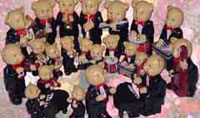Windmills
Above is just a small part of our gift-packed souvenir stamp-collection; inquire by email if the picture or subject of your interest is not here: we will be obliged to accomodate your wishes.
ここに掲載の写真は一部のみです。ご希望のジャンル、絵柄などございましたらお問い合わせください。
A windmill is an engine powered by the wind to produce energy, often contained in a large building as in traditional post mills, smock mills and tower mills. The energy windmills produce can be used in many ways, traditionally for grinding grain or spices, pumping water, sawing wood or hammering seeds. Modern wind power machines are used for generating electricity and are more properly called wind turbines.
1 History
1.1 Early history
1.2 In Europe
1.3 In the United States
2
3 External links
History
Early history
Windmills have been around for at least 1,300 years. The first windmill had vertical shafts and were reportedly built in Persia around the 7th century AD. Made of six to twelve sails covered in fabric or palm leaves, they were used to grind corn and draw up water. A similar type of vertical shaft windmill can also be found in 13th century China.
In Europe
Windmills of Western Siberia, taken by Prokudin-Gorskii, c1910
The windmills of Kinderdijk, the Netherlands
Spanish Windmills at La Mancha.
Modern windmill in Aalborg, Denmark
In Europe, windmills were developed in the Middle Ages. The earliest mills were probably grinding mills. They were mounted on city walls and could not be turned into the wind. The earliest known examples date from early 12th century Paris. Because fixed mills did not suffice for regions with changing wind directions, mill types that could be turned into the wind were developed. With some subsequent development mills became versatile in windy regions for all kind of industry, most notably grain grinding mills, sawmills (late 16th century), threshing, and, by applying Archimedes' screws, pumping mills.
With the industrial revolution, the importance of windmills as primary industrial energy source was replaced by steam and internal combustion engines. Polder mills were replaced by steam, or diesel engines. More recently historic windmills are being preserved for their historic value, which requires regular use because the wooden machinery is likely to be destroyed by maggots when the mill remains stationary for too long.
With increasing environmental concern, and approaching limits to fossil fuel consumption, wind power has regained interest as a renewable energy source. This new generation of wind mills produce electric power and are more generally referred to as wind turbines.
In the United States
Farm windmill, Sheridan County, Kansas, USA, 1939.
Double windmill and common Aeromotor windmill in Texas
The development of the water-pumping windmill in the USA was the major factor in allowing the farming and ranching of vast areas of North America, which were otherwise devoid of readily accessible water. They contributed to the expansion of rail transport systems throughout the world, by pumping water from wells to supply the needs of the steam locomotives of those early times. They are still used today for the same purpose in some areas of the world where a connection to electric power lines is not a realistic option.
The multi-bladed wind turbine atop a lattice tower made of wood or steel was, for many years, a fixture of the landscape throughout rural America. These mills, made by a variety of manufacturers, featured a large number of blades so that they would turn slowly but with considerable torque in low winds and be self regulating in high winds. A tower-top gearbox and crankshaft converted the rotary motion into reciprocating strokes carried downward through a pole or rod to the pump cylinder below..
Windmills and related equipment are still manufactured and installed today on farms and ranches, usually in remote parts of the western United States where electric power is not readily available. The arrival of electricity in rural areas, brought by the Rural Electrification Administration (REA) in the 1930s through 1950s, contributed to the decline in the use of windmills in the US. Today, with increases in energy prices and the expense of replacing electric pumps, has led to an increase in the repair, restoration and installation of new windmills.
* Renewable energy
* Land reclamation
* List of windmills
* watermill
* windpump
* wind generator
* Don Quixote
* Molinology
* klopotec
External links
* Windmills at Windmill World
* The International Molinological Society (TIMS)
* All About The American Water Pumping Windmill
* Danish Wind Industry Association
* Mill database with over 15000 mills from all over Europe
* Windmills in province Limburg, the Netherlands
* Norfolk Mills
* Windmills at the ODP
History
* Open Directory Project: Mills
* Windmillers' Gazette
* History of the Traditional American Farm Windmill
* windmillworld: history
* American Wind Power Center - An American water pumping windmill museum in Lubbock, Texas USA.
* Shattuck Windmill Museum Thirty-nine water pumping windmills used on the plains; located in Shattuck, Oklahoma
* Illinois Windmills--history and archives for the Dutch windmills in the state.
* How to construct a Windmill
Theory
Wikimedia Commons has media related to:
Windmill
* Theory of windmills
* How Does a Water Pumping Farm Windmill Work...
* Wind Power and Windmills
* A Wind Turbine for pumping water
Retrieved from "http://en.wikipedia.org/wiki/Windmill"
The above explanation comes from  出典: フリー百科事典"ウィキペディア"
出典: フリー百科事典"ウィキペディア"

